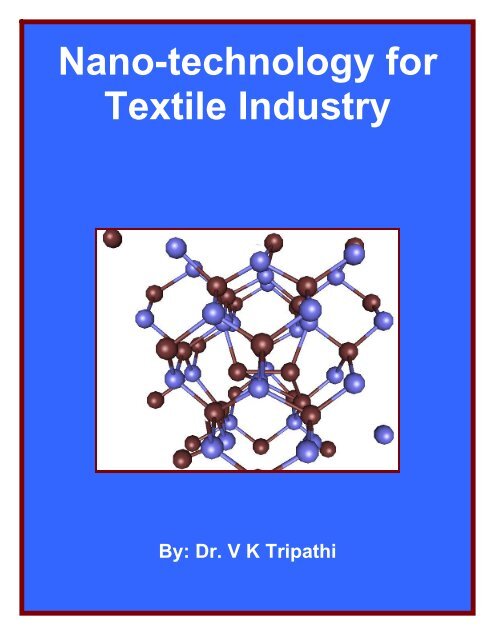Nano-technology for Textile Industry - Fibre2fashion
Nano-technology for Textile Industry - Fibre2fashion
Nano-technology for Textile Industry - Fibre2fashion
You also want an ePaper? Increase the reach of your titles
YUMPU automatically turns print PDFs into web optimized ePapers that Google loves.
<strong>Nano</strong>-<strong>technology</strong> <strong>for</strong><br />
<strong>Textile</strong> <strong>Industry</strong><br />
By: Dr. V K Tripathi
<strong>Nano</strong>-<strong>technology</strong> <strong>for</strong> <strong>Textile</strong> <strong>Industry</strong><br />
(Current products and patents)<br />
“It’s hard to think of an industry that isn’t going to be disrupted by nano<strong>technology</strong>.”<br />
-Mike Roco Senior Advisor<br />
<strong>Nano</strong><strong>technology</strong> US National Science Foundation.<br />
By: Dr. V K Tripathi
We have already started discussing the potential impact of the nano<strong>technology</strong> on our wardrobes,<br />
and the first few products of this type are already shipping. Some of them come from a company<br />
called <strong>Nano</strong> Tex, whish uses nanoscale structures to change the physical properties of clothing.<br />
Its <strong>Nano</strong>-Dry product purports to combine the strength of synthetic material such as nylon with the<br />
com<strong>for</strong>t of natural open-weaves by carrying away perspiration and moisture. It dose this by<br />
wrapping strong, durable, synthetic core fibers with specially made absorbent fibers to produce<br />
what could be called a smart heterogeneous composite nanomaterial, though we agree that<br />
calling it <strong>Nano</strong>-Dry is probably catchier. (see Figure 1)
The clothing industry is just now starting to feel the effects of nanotech. Eddie Bauer, <strong>for</strong><br />
example, is currently using embedded nanoparticals to creat stain-repellent khakis. This<br />
seemingly simple innovation will impact not only khaki-wearers, but dry cleaners, who will find<br />
their business declining; detergent makers, who will find less of their product moving off the<br />
shelves; and stain-removal makers, who will experience a sharp decrease in customers. This<br />
modest, fairly low-tech application of nano<strong>technology</strong> in just the small tip of a vast iceberg- an<br />
iceberg that threatens to sink even the “unsinkable” companies.<br />
In <strong>Nano</strong>-Tex, LLC (Emeryville, CA) the polymer system (antibacterial) have developed following<br />
products:-<br />
<strong>Textile</strong>s <strong>for</strong> apparel<br />
Interior furnishings and industrial<br />
Automotive and<br />
Medical uses (2000)<br />
In clothing manufacturing, Gore-Tex (www.gore-tex.com) offers a jacket made of a waterproof<br />
polymer membrane with embedded nano-size carbon particles that resist taking on a static<br />
charge. Such anti-static protection could be used, <strong>for</strong> example, in firefighters’ suits to help them<br />
avoid static electricity that could spark fire in a hazardous situation. <strong>Nano</strong>-Tex (www.nanotex.com)<br />
uses nano<strong>technology</strong> to produce <strong>Nano</strong>-Care stain-resistant clothing. <strong>Nano</strong>-Tex won’t<br />
give away how they incorporate their spill-resistant <strong>technology</strong>, but it’s likely that they coat the<br />
fiber with a polymer. Because the fiber are coated and then woven into fabric, the cloth maintains<br />
its strain resistance even after many washes – and the fabric maintains its soft texture and feel.<br />
They license the <strong>technology</strong> to others, including clothing giants The Gap, Nike and Old Navy.<br />
Many American and European textile companies are counting on their high-tech nano edge to<br />
survive as they compete with countries that can provide lower cost-labor.<br />
Are you a nanotech investor? In this era of nano speculation, Zyvex is one of the few companies<br />
with strong funding and solid business practices that is actually making money off of nano<br />
products and services. They are a privet company, but if they ever go public, call your broker!
<strong>Nano</strong>phase Technologies Corporation, based in Romeovill, Illinois, is currently producing<br />
nanoparticles that are being used is vinyl flooring. What makes the flooring so special is the<br />
nanoparticle coating. The nanoparticles are so tough that thy make the product difficult to scratch<br />
and are so small that they are invisible to the naked eye (remember, the nanoparticles in<br />
sunscreens, which <strong>Nano</strong>phase also manufactures, are smaller than the wavelength of ultraviolet<br />
light). These properties allow the makers of the vinyl to offer a glossy product that can rival the<br />
look of the tile, and they can offer a lifetime guarantee against rips and scratches. As a result, the<br />
flooring is taking market share away from tile manufacturers and quite likely is reducing the<br />
workload of professional tile installers.<br />
If vinyl flooring can be given a lifetime guarantee today, it stands to reason that roofing shingles,<br />
tabletop counters, and a host of other products might also be given similar guarantee in the near<br />
future. If so, what happens to the production level of roofing shingles and tabletop counters? And<br />
what about the number of contractors needed to install these products if fewer of the existing<br />
ones are wearing out?<br />
Sometimes called the building blocks of nano<strong>technology</strong>, nanoparticles (particles with diameters<br />
less than 100nm) constitute a commercially important sector of the nano<strong>technology</strong> market.<br />
Unlike many speculative applications of nano<strong>technology</strong>, nanoparticles have been with us <strong>for</strong> a<br />
while. <strong>Nano</strong>scale gold clusters have been to color ancient glass as far back a Roman civilization.<br />
More recently, in the twentieth century, carbon black – a material composed of nanoparticles of<br />
high-grade carbon “soot” – was incorporated into tires, resulting in greatly improved durability. By<br />
the year 2000, carbon black <strong>for</strong> tires was a 6-million-tons-per-year global market. <strong>Nano</strong>particles<br />
are useful when their properties at the nanoscale (mechanical, optical, magnetic, and so on) are<br />
different from those at the bulk in some beneficial way and also when their size enables<br />
interactions with biological systems.<br />
About the author:<br />
Dr. V K Tripathi is the managing director of Virtus Techno Innovations, a<br />
company dedicated to the R&D in nano<strong>technology</strong>. He is working in the field of<br />
applied nano<strong>technology</strong> since 1984. His group companies have so far filed 23<br />
patent applications in nano<strong>technology</strong>. Tripathi is also the inventor of right brain<br />
management (RBM), a patent-pending technique that can be practiced to raise<br />
the right brain utilisation of people beyond the current 1 per cent. He can be<br />
contacted at vaubt@vsnl.com Website: www.virtusti.com www.virtusti.com -<br />
(<strong>Nano</strong><strong>technology</strong>) , www.nanocet.org -(<strong>Nano</strong><strong>technology</strong>) www.vaubt.com -<br />
(Right Brain Management)<br />
To read more articles on <strong>Textile</strong>, Fashion, Apparel, Technology, Retail and General please visit<br />
www.fibre2fashion.com/industry-article<br />
To promote your company, product and services via promotional article, follow this link:<br />
http://www.fibre2fashion.com/services/featrued-article/featured_article.asp

















